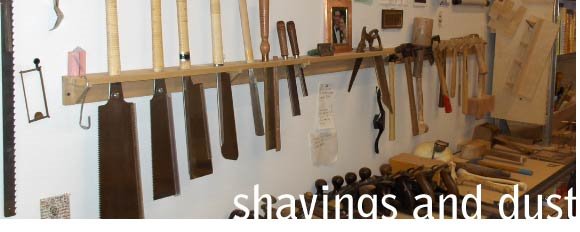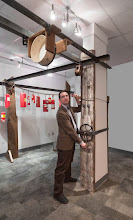Two blocks from the building in which the Design department is housed is a little cinder block building that used to be a woodworking shop. It is an uninteresting square of masonry that used to house a one-man shop that did what apparently was high end marquetry and inlay work. The remnants of ongoing projects were still in the building when I went in there, and the work that the owner was doing was at a pretty high level of craft.
What happened to the owner remains fuzzy. The roof collapsed in the building and the owner seems to have just walked away from the building leaving everything behind. I have inquired a couple of times as to where he is now, and each time the answer is non-committal and unclear. I am still trying to get to the bottom of that mystery.
The new owners of the space are a pair of local entrepreneurs that have an ethic and a world-view that are right in line with my own. Since the roof collapsed, they are the owners now of a concrete slab surrounded by cinder block wall that gets a lot of sun so they are turning it into a community garden. They contacted me, and I got a couple of students involved. For the planters we got our hands on about forty old tires, which the students and I arranged in a pleasing manner. It may seem a little low-rent as a solution for planters, but there a lot of old tires in Syracuse. They are not the kind of thing that biodegrades particularly easily and they are waterproof, so from a materials-usage standpoint, it seemed like a pretty responsible choice.
The owners also wanted some seating, and offered as material a pile of mostly Phillippine mahogany that had been left behind by the previous owner. Regular readers of this blog probably know how I feel about using tropical hardwoods and why I feel that way, but this is another of those situations in which my set of ethics has to remain flexible. Looking at that pile of wood sitting there, covered in dirt and getting rained on, I had to really rethink my feelings about what I knew was the provenance of that material.
Yes, it was cut down halfway around the world, very likely in a way that would lead to erosion of arable land, yes the person on whose land it stood probably got pennies on the dollar for cutting down and selling that tree. Yes, global shipping accounts for about 4.5% annually of greenhouse gas emissions. But it was here already. And if I did not use it, no one else would, either, and it would have been cut down completely in vain, and it would rot away into dirt over here. No matter what I think about what the material is or what its history is or the practice that this material represents, in that moment there was a pile of wood lying there in front of us, and I had to react to that. Once a tree has been made into lumber, once we have killed the living being that it was and made it into a commodity, we have a responsibility to be as thoughtful and as responsible as possible about what we do with that material. Leaving it to rot in a puddle is neither responsible nor respectful. So I agreed, and we picked up the slimy, dirty planks and brought them to the shop.

Tropical hardwoods tend to be a great choice for exterior applications. Teak and greenheart are two common examples. These dense woods are often made into boat hulls and decks as well as decks and outdoor furniture for houses. Mahogany is another one that is good for these types of uses. They tend to be rot-resistant and pretty stable, even when wet, and they tend to oxidize over time to that silky grey that cedar shakes do when left unpainted on the outside of a house or barn (This is why “Shingle Style” houses are what they are, after all, because the cedar shingles oxidize and stabilize and don’t have to be painted. Of course, culturally we have forgotten that, so everyone paints shingle houses these days, which I think is pretty weird, given that the paint has to be scraped and repainted every few years, where an unpainted shingle can last for decades. This has nothing to do with the garden, though).

So one of the students and I measured all of the lumber, and she worked up some drawings of ideas for benches, ideas that refer to the rounded top of the tires. This is her sketch. She had pretty good ideas.
I refined her ideas a little, based mostly on structural considerations, and came up with this:

Unfortunately the year had ended by the time I was able to start the build process, so the student was not able to be a part of the fabrication process, which would have been ideal. As it was, I did the fabrication alone. It was nice to move through a limited production run again, lately I have been working on one-offs, when I have worked on projects at all since I shut down my studio.
The process of doing a short run of furniture (which simply means building the same object several times by hand) has a component of dance to it. When you are doing the same operation to all four legs of a bench, and making ten benches, you do the same operation forty times. You start to look for the most efficient way to move the material through the machines, and simply moving the parts around the shop from one machine to another requires some thought. Here are the parts at one stage in the process:

Like most furniture, the front end of this project required a significant amount of work in terms of rough-milling, cutting to length and cutting the joints. For the first two days I really felt like I had not gotten very far at all, and was just moving piles of wood around the shop. But then there is the magical assembly day when after just a couple of hours there are ten (nearly) finished benches sitting on the table:

There will be no finish applied, they will just be left to weather. In all, it was a success, I think, and I am looking forward to seeing them in the garden. This project reminded me how important it is to keep making, even though the bulk of my endeavors now are in the classroom. The making of objects out of wood for people to use is near the top of my list of emotional needs, though it is easy for me to forget that and shuffle it aside. This summer is already proving restorative.


1 comment:
I'd love to see a photo of the garden with the benches in it, when you get the chance!
Also, thanks- on behalf of community gardeners everywhere- for your selfless work!
Post a Comment